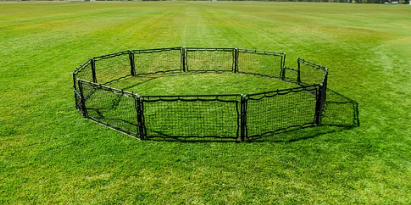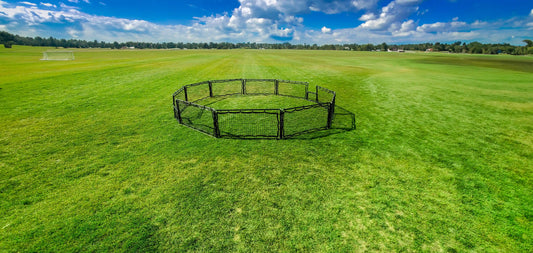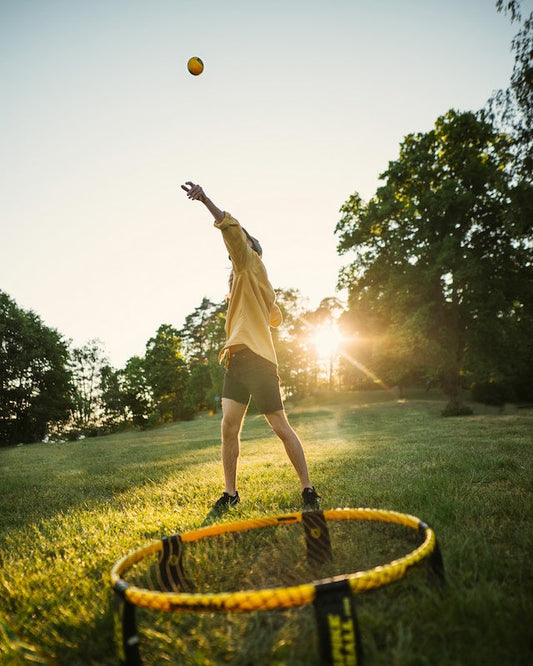In the realm of recreational sports, where the echoes of tennis, badminton, and table tennis reverberate, there exists a delightful fusion known as pickleball. It's like if tennis, badminton, and ping pong had a baby – that's pickleball for you!
Pickleball's backstory is as fascinating as the game itself. It all started with a group of friends looking for some family-friendly fun. Little did they know, their little experiment would become a global sensation. From those humble beginnings to today's packed pickleball courts and specialized pickleball equipment, pickleball's journey is a testament to its enduring popularity.
As we explore the history of pickleball, we uncover a tapestry of anecdotes and milestones, each adding to the colorful story of the sport's evolution. From makeshift courts to modern arenas, the journey is as captivating as the game itself.
So come along as we dive into pickleball history, discovering its roots, evolution, and why it's captured the hearts of so many. Whether you're a seasoned pro or just curious, there's something for everyone in the wonderful world of pickleball. Let's grab our paddles and jump into the action!

The Birth of Pickleball:
Pickleball was invented in the summer of 1965 on Bainbridge Island, Washington, by three friends—Joel Pritchard, a U.S. Congressman; Bill Bell, a successful businessman; and Barney McCallum, a local politician. The genesis of the sport is often described as a response to a classic problem: how to keep the kids entertained.
As the story goes, the Pritchard family and friends were looking for a way to engage their children in a game that would be both enjoyable and accessible. They attempted to set up a badminton game, but some equipment was missing. Improvising with what they had, they used a perforated plastic ball (similar to a whiffle ball) and lower badminton nets. The rules were adapted to suit the makeshift equipment and the limited space available.
The Name "Pickleball":
The game was an instant hit, and the Pritchard family continued to refine the rules. The sport needed a name, and according to Barney McCallum, they settled on "pickleball" after the Pritchard family dog, Pickles. However, according to Joan Pritchard, Joel Pritchard's wife, the dog Pickles came after the sport had already been named. Regardless of the exact origins of the name, "pickleball" stuck, and a new sport was born.
Spread and Growth:
Pickleball gained popularity locally on Bainbridge Island and in nearby communities. As the sport evolved, so did the equipment. Paddles replaced table tennis paddles, and the plastic ball became the standard. Pickleball started spreading to other parts of the United States, driven by the enthusiasm of those who played and the simplicity of the game, which made it accessible to people of all ages.
Formalization and Governing Bodies:
As the popularity of pickleball continued to grow, formalized rules were established. In 1972, the first known pickleball tournament took place creating a whole new bracket of pickleball professionals into the sporting scene, and the sport began to organize more officially. The USA Pickleball Association (USAPA) was founded in 1984, providing standardized rules and regulations for the game. The USAPA has played a crucial role in promoting and governing pickleball at both the recreational and competitive levels by organizing league pickleball in a variety of types.
Pickleball Today:
In recent years, pickleball has experienced explosive growth, becoming one of the fastest-growing sports in the United States and beyond. It is played in schools, community centers, retirement communities, and organized tournaments worldwide. The sport's appeal lies in its simplicity, accessibility, and the ability for players of varying skill levels to enjoy a fun and competitive game. With this games versatility in its variable competitive nature, it offers a healthy lifestyle for with limited pickleball injury to be worried about.
From its humble origins on Bainbridge Island to its global presence today, pickleball game's history reflects the creativity and adaptability of its founders and the joy that comes from a game born out of a desire for family-friendly recreation.
Pickleball is a paddle sport that requires minimal equipment, making it accessible to players of all ages and skill levels. Here's an overview of the essential equipment needed for pickleball:
Paddle:
- The pickleball paddle is a crucial piece of equipment, and it resembles a larger version of a table tennis or ping pong paddle. Paddles can vary in materials, including wood, composite materials, or a combination of both. If you're looking for a new paddles check out our selection of pickleball paddles here at Castle Sports.
- Paddles have a flat hitting surface and come in different shapes, sizes, and weights. Each pickleball player often chooses paddles based on personal preferences and playing styles.

Pickleball:
- The ball used in pickleball is similar to a whiffle ball, featuring a lightweight, perforated design. The holes in the ball reduce its speed, making it suitable for the dimensions of a pickleball court.
- Pickleballs are available in indoor and outdoor versions, each designed to perform optimally in different conditions.
Court:
- A pickleball lines are a rectangular playing surface with dimensions similar to a doubles badminton court. The court is 20 feet wide and 44 feet long for both singles and doubles play.
- The court is divided into specific zones, including the non-volley zone (often called the "kitchen") and the service areas.
Net:
- The pickleball net is similar to a tennis net but is positioned at a lower height. The net is 36 inches high at the sidelines and 34 inches high in the center.
- The net divides the court into two equal halves and extends beyond the sidelines.
Court Markings:
- The pickleball court is marked with various lines to delineate the playing area. These include the baseline, sidelines, non-volley zone line (7 feet from the net), and the centerline.
Footwear:
- Comfortable athletic shoes with non-marking soles are recommended for playing pickleball. These shoes provide traction and support while minimizing the risk of marking or damaging the court surface.
Optional equipment that some players may use includes:
Grip Enhancements:
- Overgrips or grip enhancements can be added to the handle of the paddle to improve comfort and control.
Paddle Covers:
- Paddle covers provide protection for the paddle face when not in use and can help prolong the life of the paddle.
Apparel:
- Players typically wear comfortable athletic clothing suitable for physical activity. It's important to consider the weather conditions, especially if playing outdoors.
Bag:
- A pickleball bag can be used to carry paddles, balls, and other accessories to and from the court.
Overall, the beauty of pickleball lies in its simplicity, and players can enjoy the open play with just a paddle, a ball, and access to a pickleball court. The equipment is relatively affordable, making it easy for individuals, families, and communities to engage in this fun and inclusive sport.

The dance of the pickleball ball, and the shared laughter echoing across the court, it's evident that pickleball is more than a game—it's a communal celebration of camaraderie, skill, and pure enjoyment. From the casual rallies to the intense matches, the fastest growing sport has woven itself into the fabric of recreation, uniting players young and old with the thrill of every serve and the satisfaction of a well-executed rally. As the court echoes with the memories of volleys and victories, let the spirit of pickleball linger, inviting us back to the court for another round of fun, fitness, and the unmistakable joy of the game. Until the next pickleball adventure, keep enjoying the best racket sport made!







